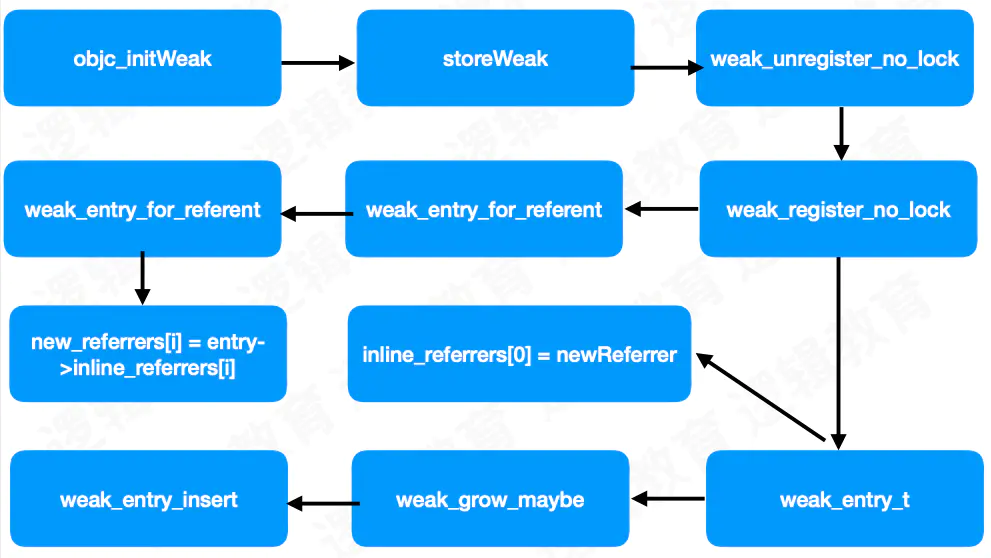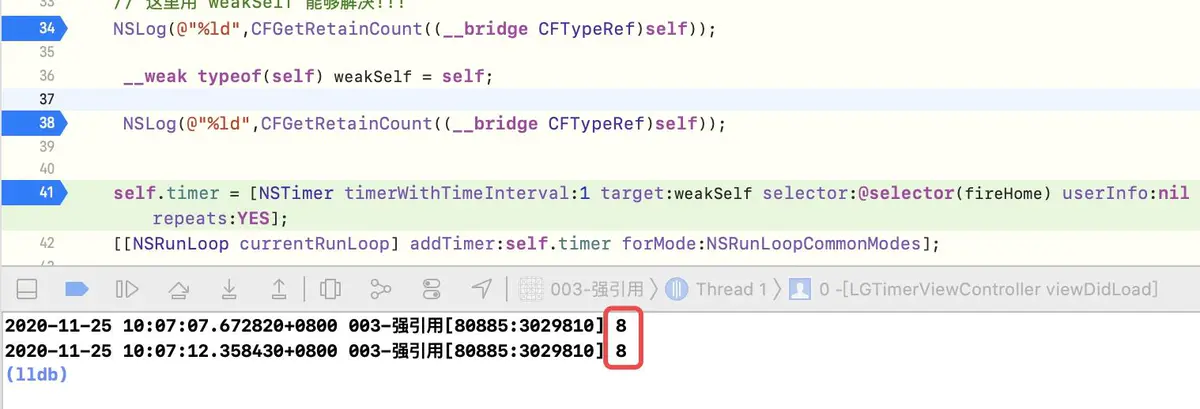033*:strong和weak,(strong=retain+release)weak(self指针地址和weakSelf地址不一样、 weakSelf没有对引用计数+1)
问题
1: weak表其实是一个哈希表,key是所指对象的指针,value是weak指针的地址数组。(value是数组的原因是:因为一个对象可能被多个弱引用指针指向)
Runtime维护了一张weak表,用来存储某个对象的所有的weak指针。
2: 当前self取地址 和 weakSelf取地址的值是不一样的
3: weakSelf没有对内存进行+1操作
目录
1:ARC & MRC
2: strong & weak
3:强弱引用
4:NSProxy虚基类
5:weakSelf 与 self
预备
正文
1. ARC & MRC
Objective-C提供了两种内存管理机制:
MRC(Mannul Reference Counting手动管理引用计数)ARC(Automatic Reference Counting自动管理引用计数)
MRC(手动管理引用计数)
- 通过
alloc、new、copy、mutableCopy生成的对象,持有时,需要使用retain、release、autoRelease管理引用计数
retain:对象的引用计数+1release:对象的引用计数-1autoRelease:自动对作用域内的对象进行一次retain和release操作。
MRC模式下,必须遵守:谁创建,谁释放,谁引用,谁管理
ARC(自动管理引用计数)
ARC在WWDC2011上公布,iOS5系统引入的自动管理机制,是LLVM和Runtime配合的结果,在编译期和运行时都会进行内存管理。ARC中禁止手动调用retain、release、retainCount、dealloc,转而使用weak、strong属性关键字。
- 现在都是直接使用
ARC,由系统自动管理引用计数了。
2. strong & weak
- 关于
strong和weak,可以在objc4源码中进行探索。 现在将流程图和总结记录一下:
2.1 weak
weak表其实是一个哈希表,key是所指对象的指针,value是weak指针的地址数组。(value是数组的原因是:因为一个对象可能被多个弱引用指针指向)
Runtime维护了一张weak表,用来存储某个对象的所有的weak指针。
weak是不处理(对象)的引用计数,而是使用一个哈希结构的弱引用表进行信息的保存。- 当
对象本身的引用计数为0时,调用dealloc函数,触发weak表的释放

弱引用表的存储细节
weak使用weakTable弱引用表进行存储信息,是sideTable散列表(哈希表)结构。- 创建
weak_entry_t,将referent引用计数加入到weak_entry_t的数组inline_referrers中。 - 支持
weak_table扩容,把new_entry加入到weak_table中
2.2 strong
strong修饰,实际是新值的retain和旧值的release:

weak:不处理引用计数,使用弱引用表进行信息存储,dealloc时移除记录。strong:内部使用retain和release进行引用计数的管理。
3. 强弱引用
- 以
NSTimer(计时器)为切入点,代码案例:
- (void)createTimer { self.timer = [NSTimer timerWithTimeInterval:1 target:self selector:@selector(fireHome) userInfo:nil repeats:YES]; [[NSRunLoop currentRunLoop] addTimer:self.timer forMode:NSRunLoopCommonModes]; } - (void)fireHome{ num++; NSLog(@"hello word - %d",num); } - (void)dealloc{ [self.timer invalidate]; self.timer = nil; NSLog(@"%s",__func__); }
NSTimer创建后,需要手动加入到Runloop中才可以运行,但timer会使得当前控制器不走dealloc方法,导致timer和控制器都无法释放。
下面,我们就来解决2个问题:
- 为什么?(
timer加入后,控制器无法释放) - 如何解决?
3.1 强持有
拓展:
无法释放,一般是循环引用导致
(注意: self作为参数传入,不会被【自动持有】,除非内部手动强引用了self。)
一般来说,
循环引用可以通过加入弱引用对象,打断循环:self -> timer ->加入weakself-> self对,
原理没错。但前提是:timer�仅被self持有,且timer仅拷贝weakself指针!很不巧:
- 当前
timer除了被self持有,还被加入了[NSRunLoop currentRunLoop]中- 当前
timer直接指向self的内存空间,是对内存进行强持有,而不是简单的指针拷贝。
所以currentRunLoop没结束,timer就不会释放,self的内存空间也不会释放。
block捕获外界变量:捕捉的是指针地址。timer捕捉的是对象本身(内存空间)
方法1:didMoveToParentViewController手动打断循环
- (void)didMoveToParentViewController:(UIViewController *)parent{ // 无论push 进来 还是 pop 出去 正常跑 // 就算继续push 到下一层 pop 回去还是继续 if (parent == nil) { [self.timer invalidate]; self.timer = nil; NSLog(@"timer 走了"); } }
方法2:不加入Runloop,使用官方闭包API
- (void)createTimer{ self.timer = [NSTimer scheduledTimerWithTimeInterval:1 repeats:YES block:^(NSTimer * _Nonnull timer) { NSLog(@"timer fire - %@",timer); }]; }
方法3:中介者模式(不使用self)
- 既然
timer会强持有对象(内存空间),我们就给他一个中介者的内存空间,让他碰不到self,我们再对中介者操作和释放。 HTTimer.h文件:
@interface HTTimer : NSObject + (instancetype)scheduledTimerWithTimeInterval:(NSTimeInterval)interval target:(id)aTarget selector:(SEL)aSelector userInfo:(nullable id)userInfo repeats:(BOOL)repeats; - (void)invalidate; - (void)fire; @end
HTTimer.m文件:
@interface HTTimer () @property (nonatomic, strong) NSTimer * timer; @property (nonatomic, weak) id aTarget; @property (nonatomic, assign) SEL aSelector; @end @implementation HTTimer + (instancetype)scheduledTimerWithTimeInterval:(NSTimeInterval)timeInterval target:(id)aTarget selector:(SEL)aSelector userInfo:(nullable id)userInfo repeats:(BOOL)repeats { HTTimer * timer = [HTTimer new]; timer.aTarget = aTarget; timer.aSelector = aSelector; timer.timer = [NSTimer scheduledTimerWithTimeInterval:timeInterval target:timer selector:@selector(run) userInfo:userInfo repeats:repeats]; [[NSRunLoop currentRunLoop] addTimer:timer.timer forMode:NSRunLoopCommonModes]; return timer; } - (void)run { //如果崩在这里,说明你没有在使用Timer的VC里面的deinit方法里调用invalidate方法 if(![self.aTarget respondsToSelector:_aSelector]) return; // 消除警告 #pragma clang diagnostic push #pragma clang diagnostic ignored "-Warc-performSelector-leaks" [self.aTarget performSelector:self.aSelector]; #pragma clang diagnostic pop } - (void)fire { [_timer fire]; } - (void)invalidate { [_timer invalidate]; _timer = nil; } - (void)dealloc { // release环境下注释掉 NSLog(@"计时器已销毁"); } @end
- 使用方法:
@interface TimerViewController () @property (nonatomic, strong) HTTimer * timer; @end @implementation TimerViewController - (void)viewDidLoad { [super viewDidLoad]; // 创建 self.timer = [HTTimer scheduledTimerWithTimeInterval:1 target:self selector:@selector(fireHome) userInfo:nil repeats:YES]; } - (void)fireHome{ NSLog(@"hello word" ); // 调用 } - (void)dealloc{ // 释放 [self.timer invalidate]; NSLog(@"%s",__func__); } @end

4: NSProxy虚基类
- 与
NSObject同级,但内部什么都没有,但是可以持有对象,并将消息全部转发给对象。
(ps: 我啥也没有,但我也是对象,我可以把你需求全部传递给能办事的对象)
这就是代理模式,timer持有代理,代理weak弱引用持有self,再把所有消息转发给self。
HTProxy.h文件
@interface HTProxy : NSProxy /// 麻烦把消息转发给`object` + (instancetype)proxyWithTransformObject:(id)object; @end
HTProxy.m文件
#import "HTProxy.h" @interface HTProxy () @property (nonatomic, weak) id object; // 弱引用object @end @implementation HTProxy /// 麻烦把消息转发给`object` + (instancetype)proxyWithTransformObject:(id)object { HTProxy * proxy = [HTProxy alloc]; proxy.object = object; return proxy; } // 消息转发。 (所有消息,都转发给object去处理) - (id)forwardingTargetForSelector:(SEL)aSelector { return self.object; } // 消息转发 self.object(可以利用虚基类,进行数据收集) //- (NSMethodSignature *)methodSignatureForSelector:(SEL)sel{ // // if (self.object) { // }else{ // NSLog(@"麻烦收集 stack111"); // } // return [self.object methodSignatureForSelector:sel]; // //} // //- (void)forwardInvocation:(NSInvocation *)invocation{ // // if (self.object) { // [invocation invokeWithTarget:self.object]; // }else{ // NSLog(@"麻烦收集 stack"); // } // //} -(void)dealloc { NSLog(@"%s",__func__); } @end
- 使用方法:
@interface TimerViewController () @property (nonatomic, strong) HTProxy * proxy; @property (nonatomic, strong) NSTimer * timer; @end @implementation TimerViewController - (void)viewDidLoad { [super viewDidLoad]; // 创建虚基类代理 self.proxy = [HTProxy proxyWithTransformObject: self]; self.timer = [NSTimer scheduledTimerWithTimeInterval:1 target:self.proxy selector:@selector(fireHome) userInfo:nil repeats:YES]; } - (void)fireHome{ NSLog(@"hello word" ); // 调用 } - (void)dealloc{ // 释放 [self.timer invalidate]; NSLog(@"%s",__func__); } @end

虚基类的代理模式使用非常方便,使用场景也很多。(注意proxy中是weak弱引用object)这样做的主要目的是将强引用的注意力转移成了消息转发。虚基类只负责消息转发,即使用NSProxy作为中间代理、中间者
这里有个疑问,定义的proxy对象,在dealloc释放时,还存在吗?
proxy对象会正常释放,因为vc正常释放了,所以可以释放其持有者,即timer和proxy,timer的释放也打破了runLoop对proxy的强持有。完美的达到了两层释放,即vc -×-> proxy <-×- runloop,解释如下:-
vc释放,导致了
proxy的释放 -
dealloc方法中,timer进行了释放,所以runloop强引用也释放了
-
这样做的主要目的是将强引用的注意力转移成了消息转发。虚基类只负责消息转发,即使用NSProxy作为中间代理、中间者
这里有个疑问,定义的proxy对象,在dealloc释放时,还存在吗?
proxy对象会正常释放,因为vc正常释放了,所以可以释放其持有者,即timer和proxy,timer的释放也打破了runLoop对proxy的强持有。完美的达到了两层释放,即vc -×-> proxy <-×- runloop,解释如下:-
vc释放,导致了
proxy的释放 -
dealloc方法中,timer进行了释放,所以runloop强引用也释放了
-
5:weakSelf 与 self
对于weakSelf和 self,主要有以下两个疑问
-
1、
weakSelf会对引用计数进行+1操作吗? -
2、
weakSelf和self的指针地址相同吗,是指向同一片内存吗? -
带着疑问,我们在
weakSelf前后打印self的引用计数
NSLog(@"%ld",CFGetRetainCount((__bridge CFTypeRef)self)); __weak typeof(self) weakSelf = self; NSLog(@"%ld",CFGetRetainCount((__bridge CFTypeRef)self));

weakSelf没有对内存进行+1操作- 继续打印
weakSelf和self对象,以及指针地址
po weakSelf po self po &weakSelf po &self
结果如下

self取地址 和 weakSelf取地址的值是不一样的。意味着有两个指针地址,指向的是同一片内存空间,即weakSelf 和 self 的内存地址是不一样,都指向同一片内存空间的
-
从上面打印可以看出,此时
timer捕获的是<LGTimerViewController: 0x7f890741f5b0>,是一个对象,所以无法通过weakSelf来解决强持有。即引用链关系为:NSRunLoop -> timer -> weakSelf(<LGTimerViewController: 0x7f890741f5b0>)。所以RunLoop对整个 对象的空间有强持有,runloop没停,timer 和 weakSelf是无法释放的 -
而我们在
Block原理中提及的block的循环引用,与timer的是有区别的。通过block底层原理的方法__Block_object_assign可知,block捕获的是对象的指针地址,即weakself 是 临时变量的指针地址,跟self没有关系,因为weakSelf是新的地址空间。所以此时的weakSelf相当于中间值。其引用关系链为self -> block -> weakSelf(临时变量的指针地址),可以通过地址拿到指针
所以在这里,我们需要区别下block和timer循环引用的模型
-
timer模型:
self -> timer -> weakSelf -> self,当前的timer捕获的是B界面的内存,即vc对象的内存,即weakSelf表示的是vc对象 -
Block模型:
self -> block -> weakSelf -> self,当前的block捕获的是指针地址,即weakSelf表示的是指向self的临时变量的指针地址
注意
引用



